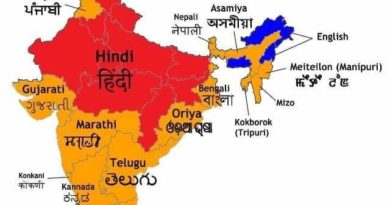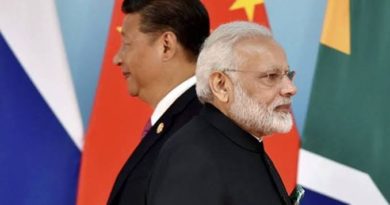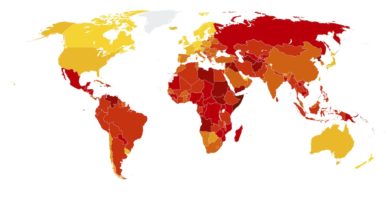A Turbulent Geopolitical Landscape lies ahead for India, need for a course correction
Presently, Indian foreign policy faces multifaceted challenges, and the first and biggest security, economic, and political challenge comes from its neighborhood – China. While India is one of the fastest growing G20 economies, the most populous country, and 5th largest economy, it aims to play a significant role globally, especially in leading the global South and becoming a key player in world politics, but difficulties hinder India’s efforts in its immediate surroundings.
The region where India is situated seems to be the most challenging region for India and does not align with India’s ambitions. In fact, it is holding India back partly due to the emergence of a very powerful neighbor in the region, presenting a unique and challenging situation for India unlike anything it has experienced before.
China’s approach of making the entire region a ‘norms-free-zone’ disrupts the geopolitical dynamics in the region, as countries in the region may find it attractive to align with a power that doesn’t impose normative conditions. On the other hand, the absence of viable alternatives for South, Central, and South East Asian countries compared to China also creates a dilemma. With China offering a non-normative alternative, India faces the challenge of adapting its approach to accommodate the changing dynamics in the region. This shift challenges India’s historical dominance in bilateral or multilateral political negotiations, setting norms and political expectations in its neighborhood.
China’s active engagement in the Belt and Road Initiative (BRI) and other projects has resulted in a growing China entanglement in the region and even beyond the mammoth Asia continent towards Africa. The BRI is a massive infrastructure and economic development project that involves investments in various countries, enhancing connectivity and trade. China’s financial capabilities and commitment to these initiatives give it a considerable advantage over India.
Although India is also actively involved in regional economic projects, China’s greater financial resources allow it to have a more significant impact and influence in the region. Notable examples of this include China’s recent multiple bilateral engagements with the Taliban-led regime in Afghanistan, support to military Junta-ruled Myanmar for many years, and financial support to economic crisis-hit Sri Lanka and strategic taking over Sri Lanka’s Hambantota port. While India also engages in diplomatic outreach, China’s efforts’ scale and financial backing contribute to a more significant overall impact in the region.
Besides, China itself has multifaceted challenges posed for India. India sees many other difficulties from the rest of its neighbors. One of the key dilemmas is the rise of politically anti-India or pro-China regimes in South Asia. For instance, in the Maldives, the new Mohamed Muizu government has taken an anti-India stance, explicitly asking Indian troops to leave and recently dropping out from a bilateral India-Maldives agreement over a water survey, which has further dented India-Maldives relations.
The upcoming general elections in Bangladesh, with the possibility of a Bangladesh Nationalist Party (BNP) led Khaleda Zia government, add another layer to India’s political dilemma as it is an ally of Jamaat e Islami, a far-right political party that has a long time anti – India stance. The fear is that such a government could be ideologically anti-India, complicating diplomatic relations and regional stability. India shared great relations under the Bangladesh Awami Party (BAP) led Sheikh Hasina regime over the last 15 years as Sheikh Hasina had a pro-India stance.
Traditionally, the U.S. was a constant geopolitical force in the region. Although its presence was not always advantageous for India or, should Rathar say, has been mostly disadvantageous for India since Independence. However, the U.S. departure is considered disadvantageous for India, given the present cordial U.S.-India ties. The absence of the United States, especially after the U.S. withdrawal from Afghanistan, has created a power vacuum, allowing other players, notably the becoming superpower China, to fill the void, and this is a cause of concern for India.
Recently, the threat of Houthi attacks on the Middle Eastern waterway, which is crucial for international trade, poses a risk for India. India’s big chunk of crude oil shipping also comes from this area. Major oil companies are now taking longer routes to deliver goods, resulting in a sharp rise in oil prices. However, India has played its stint in the ongoing Israel-Palestine war. After the Indian PM Modi’s initial support for Israel, there has been an effort to balance India’s position in the decades-old conflict. Given India’s close ties with Iran and balanced approach in the Israel – Palestine war, the Houthis risk is manageable for India for now.
It appears that between the U.S. and China standoff, the world is moving towards a clash of two supreme powers. The International Organizations and Alliances are unable to ensure deterrence and make a secure environment for all. Hence, nations have to build integral capabilities and smart partnerships. The most worrying trend is that the UN and other dispute-resolving bodies have been futile.
India should invest more resources and personnel in its diplomatic pursuits. India should increase the number and quality of its diplomats, who can effectively represent and advance India’s interests and values in the region and beyond. India should also enhance its public diplomacy and cultural outreach by showcasing its achievements, diversity, and soft power and facilitating people-to-people exchanges and interactions.
John Mearsheimer, a great political theorist, once rightfully said that the pursuit of dominance drives states, and this pursuit then leads to competition, insecurity, and, ultimately, conflict. So, this vicious cycle of accumulating powers turns out to be an unending trap for nation-states worldwide.









Your examples really helped clarify the points you were making.
This is a masterpiece, brilliantly written and incredibly informative.
Thank you, I have recently been searching for information approximately this topic for ages and yours is the best I have found out so far.
You should be proud of yourself for writing this essay; I found it to be really useful.
I really enjoyed reading this article. Your clear and concise explanations make it easy to grasp even the more complex topics. I appreciate the effort you put into providing such detailed information. This is a valuable resource for anyone looking to learn more about this subject.
This is a well-written and informative post. Your clear and concise writing style makes it easy to understand the topic, and the practical examples you provided were particularly helpful. Thank you for creating such a comprehensive resource.
Wow! Thank you! I permanently wanted to write on my blog something like that. Can I implement a portion of your post to my blog?
This actually answered my drawback, thank you!
I am really impressed with your writing skills and also with the layout on your weblog. Is this a paid theme or did you customize it yourself? Either way keep up the nice quality writing, it’s rare to see a nice blog like this one today..
Its like you read my mind! You appear to know a lot about this, like you wrote the book in it or something. I think that you can do with some pics to drive the message home a bit, but other than that, this is wonderful blog. A fantastic read. I will definitely be back.
Attractive section of content. I just stumbled upon your site and in accession capital to assert that I acquire in fact enjoyed account your blog posts. Anyway I’ll be subscribing to your augment and even I achievement you access consistently rapidly.
So nice of you
Simply desire to say your article is as astounding. The clearness in your post is simply nice and i can assume you’re an expert on this subject. Well with your permission let me to grab your RSS feed to keep up to date with forthcoming post. Thanks a million and please keep up the enjoyable work.
Thank you so much!
There is obviously a bundle to realize about this. I feel you made certain nice points in features also.
Thanks